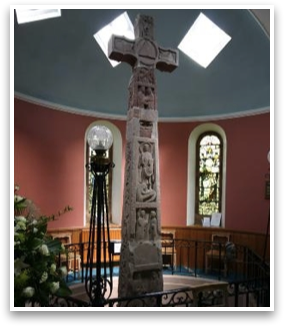
Dream of the Rood
In addition to being a wonderful poem in its own right, the anonymous Old English poem "Dream of the Rood" is significant in demonstrating the issues faced in integrating a Christian worldview, which treasures such virtues as peace, kindness, love, and patience, with an Anglo-Saxon warrior culture.
While thought to be a late 10th-century manuscript, portions of the poem from an earlier date can be seen on the Ruthwell Cross, pictured to the left.
Study Questions
- What is the significance of the anthropomorphizing of the cross itself? What effect does that have on the poem's power?
- What specific images or metaphors are particularly striking?
- How, exactly, does the author make Christianity (and the figure of Christ) appealing to a warrior culture? After all, being crucified was at once a humiliating and passive experience. How was this sign of defeat transformed into a mark of triumph?
The anonymous author of the "Dream of the Rood" succinctly and masterfully transforms the passive figure of a dying Christ into a triumphant warrior, thus fusing the values of Christianity with those of the Anglo-Saxon world.